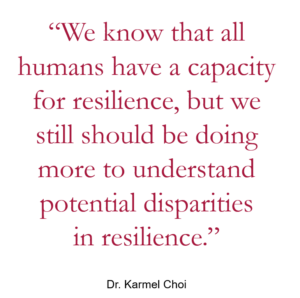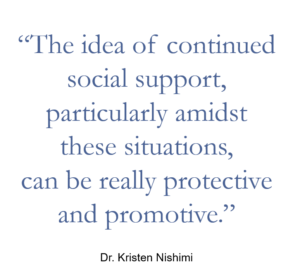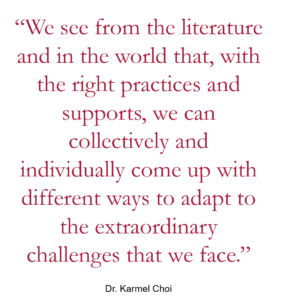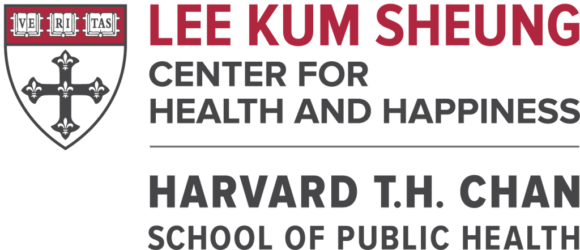Dr. Karmel Choi is a Research Advisor for the Center and a Clinical and Research Fellow in the Psychiatric & Neurodevelopmental Genetics Unit at Massachusetts General Hospital (MGH) and the Harvard T.H. Chan School of Public Health. Dr. Kristen Nishimi earned her PhD from the Harvard T.H. Chan School of Public Health in 2020. Her dissertation, “Psychological Resilience & Cardiometabolic Health: Biological, Lifestyle, & Disease Outcomes,” received a Center Dissertation Research Award in 2019. In this interview, Dr. Choi and Dr. Nishimi discuss the science of resilience and the framework it provides for understanding individuals and communities affected by the COVID-19 pandemic.
Q: What can the science of resilience teach us about managing the mental health impact of the COVID-19 pandemic?
Karmel Choi: The science of resilience, broadly, tells us that resilience is the norm rather than the exception. More than half of the US population will experience some kind of highly stressful or traumatic event in their lifetime, and right now the number might be even higher, but only a small proportion of us will go on to experience a debilitating mental health condition like PTSD. So I think that’s, first of all, a hopeful message—that the mental health impact of the pandemic definitely will be there, but I think that a lot of us are also in a position to ultimately recover do better than we might expect.

Kristen Nishimi: I think the science of resilience is an always-evolving thing, as is the construct of resilience itself. So that makes it hard, but also really interesting, to draw really specific suggestions about what to do. But we know that resilience is dynamic—dependent on both the adversity or challenge that people are facing, as well as factors that can protect or promote resilience. Those factors can be internal or external and can also change and evolve over time. A key thing that resilience research can tell us about the current situation is that there are a bunch of these individual or external factors that are found to promote mental health resilience, and one of the most consistent predictors is social support, or having positive, beneficial relationships. Social connection is probably really important during this time. The second thing I’ll say about applying the science of resilience to the pandemic is the importance of flexibility and adaptiveness of people’s coping responses, or how they’re responding to the pandemic and this new situation that everyone’s in. Flexibility might be more important than any universal best way to “be” or cope in this time.
 Karmel Choi: Building on what Kristen said about flexibility, if we draw on systems science and other literature, we can take a look at things in the world that are inherently resilient. For example, we know that some metals can bend well and absorb force when physical stress is applied, and there are other types of materials that simply resist against outside forces, and that actually makes them more likely to break under pressure. In that same way, resilience is less about pushing through tough circumstances at all costs, but really about having the flexibility to change and adapt through challenges.
Karmel Choi: Building on what Kristen said about flexibility, if we draw on systems science and other literature, we can take a look at things in the world that are inherently resilient. For example, we know that some metals can bend well and absorb force when physical stress is applied, and there are other types of materials that simply resist against outside forces, and that actually makes them more likely to break under pressure. In that same way, resilience is less about pushing through tough circumstances at all costs, but really about having the flexibility to change and adapt through challenges.
I spoke about this recently for the Psychiatric Genomics Consortium, and shared a couple practical lessons for managing the mental health impact of the pandemic at a personal level. One lesson for flexibility and resilience is to actually allow for mental health impact instead of resisting or ignoring it. That means acknowledging all the reactions that we’re having, including feelings like frustration, sadness, anxiety, or loss, which are completely normal. Doing this actually helps us move through these reactions instead of getting stuck. A second lesson on resilience is that we may need to adjust or recalibrate our expectations, instead of holding ourselves to one standard of productivity or functioning. By giving ourselves permission to function a little differently right now, we can do better over the long run and take care of the needs of those around us. The third lesson, circling back to flexibility and how we cope, is matching our actions to the situation. If there are things that we can change right now about going through this pandemic, we can do some planning and try to solve the situation. But if some things are truly out of our control, like the economy or something like that, we can switch to other strategies, like talking to other people for support, or taking care of our needs. This kind of flexibility, as we see from the literature and also the world, can help us recover more efficiently during these times.
Q: What does the science say about factors that promote resilience?
Karmel Choi: The science says that there are many factors at our disposal to promote resilience. George Bonanno presented a great summary of the science at his recent seminar in the fall. We know that there are lots of different factors that can promote resilience after adversity. And each one accounts for a small portion of variation that we see in these outcomes. These factors can range from biological factors, like areas of the brain that support emotion regulation; they can include personality traits like optimism, or the tendency to experience positive emotions, cognitive factors, social support—which we already know is highly important—and behaviors like coping styles, and of course physical activity, which I study as well.
Kristen Nishimi: Exactly. Like Karmel said, there’s no single factor, individual characteristic, or even broader characteristic, that is usually found to fully explain resilience. There are also other social, community or macro-level factors that we focus on—including the broader social determinants of health—that can influence resilience directly, or can influence the distribution of these more individual-level factors. I think that these determinants, like socioeconomic status, racial discrimination, economic and educational inequalities, features of our built environments, can all influence whether individuals or populations become resilient or not.
Karmel Choi: I would add that research and theory would suggest that resilience is not this fixed individual-level trait or ability. That’s something that we both focus on in our research. As Kristen mentioned, it’s really this ongoing process of retaining or recovering our mental health in the face of adversity. Our research has suggested that there is a genetic component to resilience, but resilience isn’t something that you actually need to be born with. It’s very much affected by what we do, how we think and relate to the world. Also, the support and the resources and the systems, those macro-level processes around us, can have a huge difference on our resilience, too. So that makes resilience both an individual and collective process, and it’s one that we need to promote and address on multiple levels.
Q: Do outcomes for resilience look similar across groups?
Kristen Nishimi: There are some mixed findings in terms of domains like sex or gender. Some evidence has shown that men tend to be more resilient than women (e.g., Bonanno & Diminich 2013), but it’s pretty varied and can depend on the type of adversity experienced, what you’re measuring as resilience, time in the life course, things like that. In terms of age, there has also been some evidence that young people, as well as older adults, tend to be at higher risk of poorer outcomes when faced with adversity. Again, that’s not to say that every young person or every older person would not be able to be resilient, but those people tend to potentially be more negatively impacted by adversity given their availability of resilience-promoting resources or their ability to make use of these resources effectively.

Karmel Choi: Young people, because their brains are still in the process of developing, can be more vulnerable to the effects of adversity and stress. But this same plasticity in the brain can also offer an opportunity for positive inputs to reverse these effects: so what makes them vulnerable also makes them able to bounce back. Another thing to note is that young people are also more dependent within a caregiving system, so there are some factors at the family level that can matter more than for adults, like having a caring and stable adult person present, and how well their caregiver can help regulate their anxiety and stress.
I also wanted to comment on socioeconomic differences. We know that all humans have a capacity for resilience, but we still should be doing more to understand potential disparities in resilience. We know that some protective factors and resources—whether it’s the ability to have a safe place to exercise, or time to practice self-care, or even access to mental health services—can be distributed unequally across groups, whether it’s racial groups, social groups, or gender groups. So we may, in fact, see differences in resilience because of these things. From studying resilience, we know that it’s important to also take into account the amount of stress or challenge that someone is going through. Resilience is really about how well you’re doing compared to what you’re going through. Social disadvantage, for example, can definitely multiply the stress and challenges people are going through. We know the impact of COVID-19 is hitting some communities harder than others, both health-wise and financially, so that may require a lot more to overcome or offset that burden. So everyone has a capacity for resilience, but we may not all be starting on the same foot, and we need to understand how to rectify those differences, too.
Q: Have we learned any lessons about resilience from prior natural disasters that could inform what we might do to enhance resilience in response to COVID-19?
Karmel Choi: One thing we’ve learned from natural disaster response is that after a catastrophic event, the first immediate goal is to stabilize people and meet their immediate needs for safety. So during a crisis like COVID-19, we should definitely be thinking about long-term supports and how to ensure well-being, but in the short term, we really need to first think about what people’s day-to-day needs are, and how to lay a solid foundation for that. Once we meet these more basic needs, we can then think about boosting coping, resilience, and well-being.
We also know from other events, like 9/11, that media and news exposure can also play into responses that people have, long term, after a natural disaster. So we need to mindful about that, too, as a society and how we consume our news, getting information from official sources and not spending too much time on media. Then the last thing that comes to mind right now is that with any catastrophic event, the ability to come together in some way, and not feel isolated in that experience, is really critical for moving forward.
Kristen Nishimi: I totally agree. I think the preparedness before such an event, actions during the peak crisis time—which in this case is particularly prolonged—as well as what we do afterwards to rebuild, will all be really important both for immediate and long-term mental health in the people experiencing it. Some of the research on disaster situations and resilience shows that consistent leadership and coordinated action in local or municipal levels can be really effective in getting those necessary supports to protect the safety of individuals. This then enables people to do better in terms of mental health and promotes resilience. To echo another thing Karmel said, collectiveness and community-level cohesion both before and during these experiences tends to be a really strong predictor of how people do post-disaster. Harkening back, the idea of continued social support, particularly amidst these situations, can be really protective and promotive.
Q: What new challenges to individual and community resilience does COVID-19 present?
Karmel Choi: The pandemic has really changed the access we have to some of the most potent resilience factors and processes. Our research and many others’ have shown that social connections are key to supporting resilience over time, and this is being challenged in an unprecedented way during the COVID-19 pandemic, where we actually have to physically distance ourselves from those who could be most supportive to us. Other gatherings and rituals, including funerals—which have been possible after really devastating events like 9/11, or even mass shootings—those types of gatherings represent a key part of healing and are also not possible right now. The distancing and the need to prevent disease transmission, but at the cost of being able to gather and to support each other in person, has been a major challenge during this time.
Kristen Nishimi: I agree, that’s one of the main challenges unique to this situation. Also, the clear economic impact, both currently and into the future, and the level of uncertainty and anxiety that it’s causing for everyone, feels pretty unprecedented in this situation. And we know, as Karmel has said, that economic resources are among the things that permit or prevent access to the resources that we need to be resilient. We’ve already started to see the impact of the pandemic exacerbating pre-existing disparities in health and well-being in the population, and this will likely continue with the prolonged economic impact.
Karmel Choi: Another challenge is physical activity and its role in protecting mental health—and physical activity defined very broadly in terms of just moving and being out and about in the world. With the home quarantine measures, that is also really being challenged right now and has raised the need to think more creatively about ways to get active. It’s certainly possible: just like social support, we are finding other ways to connect and confide in each other, and share and support and uplift each other from afar. This time has required a lot of adaptations to figure out how to still harness the benefits of some of these things we know to be helpful but may not be able to use in the same ways as usual.
Q: In today’s climate of loss and uncertainty, how does your work provide hope for positive outcomes?
Kristen Nishimi: What we know from the literature and from work that we’ve done is that everybody does have the capacity to be resilient; people have experienced trauma and tragedies throughout history and have been able to recover and live promotive, full lives. I think this individual and collective capacity for resilience is pretty inspiring. You see evidence everywhere—across academic literature, in social media, among more mainstream news—of the resilience of people and communities. And I think it’s good to remember that. We do have the capacity for resilience, and there is hope. Additionally, we are now more connected virtually than we’ve ever been before. The ability to reach out and connect with loved ones, friends, family and colleagues, through the virtual capacities that we can, is definitely a positive in this really negative time.
Karmel Choi: Our work and the work of many others all point to ordinary magic of resilience, which is a term that Ann Masten has coined. When we’re faced with really challenging times, there’s no doubt that there is going to be a lot of anxiety and fear and stress and sadness, but we see from the literature and in the world that, with the right practices and supports, we can collectively and individually come up with different ways to adapt to the extraordinary challenges that we face. We, as a society, can do better than we expect, and we can harness that ordinary magic.

You must be logged in to post a comment.